The Effectiveness of Digital vs. Analogue Teaching Resources in a Flipped Classroom for Undergraduate Focus Cardiac Ultrasound Training: A Prospective, Randomised, Controlled Single-Centre Study
Abstract
1. Introduction
Research Focus and Aim of the Present Study
2. Materials and Methodology
2.1. Study Design, Participant Recruitment, and Study Procedure
2.2. Formulation of Training Concept
2.3. Procedure of the Training Concept
2.4. Teaching Materials
2.4.1. E-Learning
2.4.2. Hard-Copy Lecture Notes
2.5. Test and Evaluation Instruments
2.5.1. Evaluations
2.5.2. Theory Test
2.5.3. Practical Examinations
2.5.4. Statistical Analysis
3. Results
3.1. Data Description
3.2. Baseline Characteristics of the Study and Control Group
3.3. Motivation, Course Concept, Teaching Materials, and Learning Objectives
3.4. Development of Subjective Competence
3.5. Development of Objective Competences
3.5.1. Theory
3.5.2. Direct Observation of Procedural Skills (DOPS) Tests—Results
3.5.3. Influencing Factors and Correlations
3.5.4. Correlations
4. Discussion
Limitations
5. Conclusions
Supplementary Materials
Author Contributions
Funding
Institutional Review Board Statement
Informed Consent Statement
Data Availability Statement
Acknowledgments
Conflicts of Interest
References
- Abplanalp, S., Hari, R., Blaivas, M., Westerway, S. C., Chammas, M. C., Hoffmann, B., Jenssen, C., Leung, K.-Y., Möller, K., Qingli, Z., Rahhal, H., Wan, Y.-L., Weimer, J., & Dietrich, C. F. (2025). History of student ultrasound education: Learning from working examples. Medical Ultrasonography. online ahead of print. [Google Scholar] [CrossRef] [PubMed]
- Altersberger, M., Pavelka, P., Sachs, A., Weber, M., Wagner-Menghin, M., & Prosch, H. (2019). Student perceptions of instructional ultrasound videos as preparation for a practical assessment. Ultrasound International Open, 5(3), E81–E88. [Google Scholar] [CrossRef]
- Beaulieu, Y., Laprise, R., Drolet, P., Thivierge, R. L., Serri, K., Albert, M., Lamontagne, A., Bélliveau, M., Denault, A. Y., & Patenaude, J. V. (2015). Bedside ultrasound training using web-based e-learning and simulation early in the curriculum of residents. Critical Ultrasound Journal, 7(1), 1. [Google Scholar] [CrossRef] [PubMed]
- Blackstock, U., Munson, J., & Szyld, D. (2015). Bedside ultrasound curriculum for medical students: Report of a blended learning curriculum implementation and validation. Journal of Clinical Ultrasound, 43(3), 139–144. [Google Scholar] [CrossRef] [PubMed]
- Blank, V., Strobel, D., & Karlas, T. (2022). Digital training formats in ultrasound diagnostics for physicians: What options are available and how can they be successfully integrated into current DEGUM certified course concepts? Ultraschall in der Medizin, 43(5), 428–434. [Google Scholar] [CrossRef]
- Breitkreutz, R., Uddin, S., Steiger, H., Ilper, H., Steche, M., Walcher, F., Via, G., & Price, S. (2009). Focused echocardiography entry level: New concept of a 1-day training course. Minerva Anestesiologica, 75(5), 285–292. [Google Scholar]
- Canty, D., Barth, J., Yang, Y., Peters, N., Palmer, A., Royse, A., & Royse, C. (2019). Comparison of learning outcomes for teaching focused cardiac ultrasound to physicians: A supervised human model course versus an eLearning guided self-directed simulator course. Journal of Critical Care, 49, 38–44. [Google Scholar] [CrossRef]
- Cawthorn, T. R., Nickel, C., O’Reilly, M., Kafka, H., Tam, J. W., Jackson, L. C., Sanfilippo, A. J., & Johri, A. M. (2014). Development and evaluation of methodologies for teaching focused cardiac ultrasound skills to medical students. Journal of the American Society of Echocardiography, 27(3), 302–309. [Google Scholar] [CrossRef]
- Chiem, A. T., Soucy, Z., Dinh, V. A., Chilstrom, M., Gharahbaghian, L., Shah, V., Medak, A., Nagdev, A., Jang, T., Stark, E., & Hussain, A. (2016). Integration of ultrasound in undergraduate medical education at the California medical schools: A discussion of common challenges and strategies from the UMeCali experience. Journal of Ultrasound in Medicine, 35(2), 221–233. [Google Scholar] [CrossRef]
- Chisholm, C. B., Dodge, W. R., Balise, R. R., Williams, S. R., Gharahbaghian, L., & Beraud, A. S. (2013). Focused cardiac ultrasound training: How much is enough? Journal of Emergency Medicine, 44(4), 818–822. [Google Scholar] [CrossRef]
- Cosyns, B., De Diego, J. J. G., Stefanidis, A., Galderisi, M., Ernande, L., Underwood, S. R., Bucciarelli-Ducci, C., Lancellotti, P., & Habib, G. (2015). E-learning in cardiovascular imaging: Another step towards a structured educational approach. European Heart Journal Cardiovascular Imaging, 16, 463–465. [Google Scholar] [CrossRef] [PubMed]
- Darras, K. E., Spouge, R. J., de Bruin, A. B. H., Sedlic, A., Hague, C., & Forster, B. B. (2021). Undergraduate radiology education during the COVID-19 pandemic: A review of teaching and learning strategies. Canadian Association of Radiologists Journal, 72(2), 194–200. [Google Scholar] [CrossRef]
- Daum, N., Blaivas, M., Goudie, A., Hoffmann, B., Jenssen, C., Neubauer, R., Recker, F., Moga, T. V., Zervides, C., & Dietrich, C. F. (2024). Student ultrasound education, current view and controversies. Role of Artificial Intelligence, Virtual Reality and telemedicine. The Ultrasound Journal, 16(1), 44. [Google Scholar] [CrossRef] [PubMed]
- Dickerson, J., Paul, K., Vila, P., & Whiticar, R. (2017). The role for peer-assisted ultrasound teaching in medical school. Clin Teach, 14(3), 170–174. [Google Scholar] [CrossRef]
- Dieden, A., Carlson, E., & Gudmundsson, P. (2019). Learning echocardiography-what are the challenges and what may favour learning? A qualitative study. BMC Medical Education, 19(1), 212. [Google Scholar] [CrossRef]
- Ding, K., Chen, M., Li, P., Xie, Z., Zhang, H., Kou, R., Xu, J., Zou, T., Luo, Z., & Song, H. (2024). The effect of simulation of sectional human anatomy using ultrasound on students’ learning outcomes and satisfaction in echocardiography education: A pilot randomized controlled trial. BMC Medical Education, 24(1), 494. [Google Scholar] [CrossRef]
- Duncan, E., O’Cathain, A., Rousseau, N., Croot, L., Sworn, K., Turner, K. M., Yardley, L., & Hoddinott, P. (2020). Guidance for reporting intervention development studies in health research (GUIDED): An evidence-based consensus study. BMJ Open, 10(4), e033516. [Google Scholar] [CrossRef] [PubMed]
- Elshami, W., Taha, M. H., Abdalla, M. E., Abuzaid, M., Saravanan, C., & Al Kawas, S. (2022). Factors that affect student engagement in online learning in health professions education. Nurse Education Today, 110, 105261. [Google Scholar] [CrossRef]
- Fuchs, L., Gilad, D., Mizrakli, Y., Sadeh, R., Galante, O., & Kobal, S. (2018). Self-learning of point-of-care cardiac ultrasound—Can medical students teach themselves? PLoS ONE, 13(9), e0204087. [Google Scholar] [CrossRef]
- Gat, T., Galante, O., Sadeh, R., Kobal, S. L., & Fuchs, L. (2024). Self-learning of cardiac ultrasound by medical students: Can augmented online training improve and maintain manual POCUS skills over time? Journal of Ultrasoun, 27(1), 73–80. [Google Scholar] [CrossRef]
- Gradl-Dietsch, G., Menon, A. K., Gürsel, A., Götzenich, A., Hatam, N., Aljalloud, A., Schrading, S., Hölzl, F., & Knobe, M. (2018). Basic echocardiography for undergraduate students: A comparison of different peer-teaching approaches. European Journal of Trauma and Emergency Surgery, 44(1), 143–152. [Google Scholar] [CrossRef] [PubMed]
- Greim, C. A., Weber, S., & Goepfert, M. (2017). Perioperative fokussierte echokardiographie in der anästhesiologie und intensivmedizin. Anasthesiologie und Intensivmedizin, 58, 617–621. [Google Scholar]
- Guze, P. A. (2015). Using technology to meet the challenges of medical education. Transactions of the American Clinical and Climatological Association, 126, 260–270. [Google Scholar]
- Hagendorff, A., Fehske, W., Flachskampf, F. A., Helfen, A., Kreidel, F., Kruck, S., La Rosée, K., Tiemann, K., Voigt, J. U., von Bardeleben, R. S., & Zahn, R. (2020). Manual zur Indikation und Durchführung der Echokardiographie—Update 2020 der Deutschen Gesellschaft für Kardiologie. Der Kardiologe, 14(5), 396–431. [Google Scholar] [CrossRef]
- Hagendorff, A., Tiemann, K., Simonis, G., Campo dell‘ Orto, M., & von Bardeleben, S. (2013). Empfehlungen zur Notfallechokardiographie. Der Kardiologe, 8(1), 45–64. [Google Scholar] [CrossRef]
- Harel-Sterling, M. (2023). Can you teach a hands-on skill online? A scoping review of e-learning for point-of-care ultrasound in medical education. Canadian Medical Education Journal, 14(6), 66–77. [Google Scholar] [CrossRef]
- Hari, R., Kalin, K., Harris, M., Walter, R., & Serra, A. (2020). Comparing blended learning with faculty-led ultrasound training: Protocol for a randomised controlled trial (the SIGNATURE trial). Praxis, 109(8), 636–640. [Google Scholar] [CrossRef]
- Haskins, S. C., Feldman, D., Fields, K. G., Kirksey, M. A., Lien, C. A., Luu, T. H., Nejim, J. A., Osorio, J. A., & Yang, E. I. (2018). Teaching a point-of-care ultrasound curriculum to anesthesiology trainees with traditional didactic lectures or an online e-learning platform: A pilot study. Journal of Education in Perioperative Medicine, 20(3), E624. [Google Scholar]
- Heinz, W. (2016). Basisausbildung notfallsonographie. Available online: https://www.degum.de/fileadmin/dokumente/arbeitskreise/notfallsonographie/mehrstufenkonzept/Basisausbildung_DEGUM_Notfallsonographie_Stand_24062016_Korr._06.11.2018.pdf (accessed on 10 October 2024).
- Hempel, C., Turton, E., Hasheminejad, E., Bevilacqua, C., Hempel, G., Ender, J., & Rotzoll, D. (2020). Impact of simulator-based training on acquisition of transthoracic echocardiography skills in medical students. Annals of Cardiac Anaesthesia, 23(3), 293–297. [Google Scholar] [CrossRef]
- Hempel, D., Sinnathurai, S., Haunhorst, S., Seibel, A., Michels, G., Heringer, F., Recker, F., & Breitkreutz, R. (2016). Influence of case-based e-learning on students’ performance in point-of-care ultrasound courses: A randomized trial. European Journal of Emergency Medicine, 23(4), 298–304. [Google Scholar] [CrossRef]
- Herbert, A., Russell, F. M., Zahn, G., Zakeri, B., Motzkus, C., Wallach, P. M., & Ferre, R. M. (2022). Point-of-care ultrasound education during a pandemic: From webinar to progressive dinner-style bedside learning. Cureus, 14(5), e25141. [Google Scholar] [CrossRef]
- Hoppmann, R. A., Mladenovic, J., Melniker, L., Badea, R., Blaivas, M., Montorfano, M., Abuhamad, A., Noble, V., Hussain, A., Prosen, G., & Villen, T. (2022). International consensus conference recommendations on ultrasound education for undergraduate medical students. The Ultrasound Journal, 14(1), 31. [Google Scholar] [CrossRef] [PubMed]
- Höhne, E., Recker, F., Dietrich, C. F., & Schäfer, V. S. (2022). Assessment methods in medical ultrasound education. Frontiers in Medicine, 9, 871957. [Google Scholar] [CrossRef]
- Johri, A. M., Durbin, J., Newbigging, J., Tanzola, R., Chow, R., De, S., & Tam, J. (2018). Cardiac point-of-care ultrasound: State-of-the-art in medical school education. Journal of the American Society of Echocardiography, 31(7), 749–760. [Google Scholar] [CrossRef] [PubMed]
- Jujo, S., Sakka, B. I., Lee-Jayaram, J. J., Kataoka, A., Izumo, M., Kusunose, K., Nakahira, A., Oikawa, S., Kataoka, Y., & Berg, B. W. (2022). Medical student medium-term skill retention following cardiac point-of-care ultrasound training based on the American Society of Echocardiography curriculum framework. Cardiovascular Ultrasound, 20(1), 26. [Google Scholar] [CrossRef] [PubMed]
- Khoury, M., Fotsing, S., Jalali, A., Chagnon, N., Malherbe, S., & Youssef, N. (2020). Preclerkship point-of-care ultrasound: Image acquisition and clinical transferability. Journal of Medical Education and Curricular Development, 7, 2382120520943615. [Google Scholar] [CrossRef]
- Kobal, S. L., Lior, Y., Ben-Sasson, A., Liel-Cohen, N., Galante, O., & Fuchs, L. (2017). The feasibility and efficacy of implementing a focused cardiac ultrasound course into a medical school curriculum. BMC Medical Education, 17(1), 94. [Google Scholar] [CrossRef]
- Kusurkar, R. A., Ten Cate, T. J., van Asperen, M., & Croiset, G. (2011). Motivation as an independent and a dependent variable in medical education: A review of the literature. Medical Teacher, 33(5), e242–e262. [Google Scholar] [CrossRef]
- Kühl, M. (2012). Student tutors for hands-on training in focused emergency echocardiography—A randomized controlled trial. BMC Medical Education, 12, 101. [Google Scholar] [CrossRef]
- Lien, W. C., Lin, P., Chang, C. H., Wu, M. C., & Wu, C. Y. (2023). The effect of e-learning on point-of-care ultrasound education in novices. Medical Education Online, 28(1), 2152522. [Google Scholar] [CrossRef]
- Lin, M.-H., Chen, H.-C., & Liu, K.-S. (2017). A study of the effects of digital learning on learning motivation and learning outcome. Eurasia Journal of Mathematics, Science and Technology Education, 13, 3553–3564. [Google Scholar] [CrossRef]
- Mahdavi Ardestani, S. F., Adibi, S., Golshan, A., & Sadeghian, P. (2023). Factors influencing the effectiveness of e-learning in healthcare: A fuzzy ANP study. Healthcare, 11(14), 2035. [Google Scholar] [CrossRef] [PubMed]
- Moher, D., Hopewell, S., Schulz, K. F., Montori, V., Gøtzsche, P. C., Devereaux, P. J., Elbourne, D., Egger, M., & Altman, D. G. (2010). CONSORT 2010 explanation and elaboration: Updated guidelines for reporting parallel group randomised trials. BMJ, 340, c869. [Google Scholar] [CrossRef]
- Neskovic, A. N., Edvardsen, T., Galderisi, M., Garbi, M., Gullace, G., Jurcut, R., Dalen, H., Hagendorff, A., & Lancellotti, P. (2014). Focus cardiac ultrasound: The European Association of Cardiovascular Imaging viewpoint. European Heart Journal—Cardiovascular Imaging, 15(9), 956–960. [Google Scholar] [CrossRef] [PubMed]
- Neskovic, A. N., Hagendorff, A., Lancellotti, P., Guarracino, F., Varga, A., Cosyns, B., Flachskampf, F. A., Popescu, B. A., Gargani, L., Zamorano, J. L., & Badano, L. P. (2013). Emergency echocardiography: The European Association of Cardiovascular Imaging recommendations. European Heart Journal—Cardiovascular Imaging, 14(1), 1–11. [Google Scholar] [CrossRef] [PubMed]
- Neskovic, A. N., Skinner, H., Price, S., Via, G., De Hert, S., Stankovic, I., Galderisi, M., Donal, E., Muraru, D., Sloth, E., & Gargani, L. (2018). Focus cardiac ultrasound core curriculum and core syllabus of the European Association of Cardiovascular Imaging. European Heart Journal Cardiovascular Imaging, 19(5), 475–481. [Google Scholar] [CrossRef]
- Neubauer, R., Bauer, C. J., Dietrich, C. F., Strizek, B., Schäfer, V. S., & Recker, F. (2024). Evidence-based ultrasound education?—A systematic literature review of undergraduate ultrasound training studies. Ultrasound International Open, 10, a22750702. [Google Scholar] [CrossRef]
- Obeng-Okyere, P., Norbu, T., & Hahn, H. (2019). Point of care use of an appropriate use criteria smartphone app for echocardiography. Journal of the American Society Echocardiogr, 32(8), 1048–1049. [Google Scholar] [CrossRef]
- Parra, V. M., Fita, G., Azqueta, M., González, M., Aranda, F., Maestre, M. L., Silva, J., Hortal, J., Morales, D., Bórquez, E., & Adasme, F. (2024). Student survey after ten years of continuous blended teaching of echocardiography. Revista Española de Anestesiología y Reanimación (English Edition), 71(1), 8–16. [Google Scholar] [CrossRef]
- Popescu, B. A., Andrade, M. J., Badano, L. P., Fox, K. F., Flachskampf, F. A., Lancellotti, P., Varga, A., Sicari, R., Evangelista, A., Nihoyannopoulos, P., & Zamorano, J. L. (2009). European Association of Echocardiography recommendations for training, competence, and quality improvement in echocardiography. European Journal of Echocardiographie, 10(8), 893–905. [Google Scholar] [CrossRef]
- Popescu, B. A., Stefanidis, A., Fox, K. F., Cosyns, B., Delgado, V., Di Salvo, G. D., Donal, E., Flachskampf, F. A., Galderisi, M., Lancellotti, P., & Muraru, D. (2020). Training, competence, and quality improvement in echocardiography: The European association of cardiovascular imaging recommendations: Update 2020. European Heart Journal—Cardiovascular Imaging, 21(12), 1305–1319. [Google Scholar] [CrossRef] [PubMed]
- Price, S., Via, G., Sloth, E., Guarracino, F., Breitkreutz, R., Catena, E., & Talmor, D. (2008). Echocardiography practice, training and accreditation in the intensive care: Document for the world interactive network focused on critical ultrasound (WINFOCUS). Cardiovasc Ultrasound, 6, 49. [Google Scholar] [CrossRef] [PubMed]
- Puthiaparampil, T., & Rahman, M. M. (2020). Very short answer questions: A viable alternative to multiple choice questions. BMC Medical Education, 20(1), 141. [Google Scholar] [CrossRef]
- Reyna, J. (2013). The importance of visual design and aesthetics in e-learning. Training & Development, 40, 28. [Google Scholar]
- Röhrig, S., Hempel, D., Stenger, T., Armbruster, W., Seibel, A., Walcher, F., & Breitkreutz, R. (2014). Which learning methods are expected for ultrasound training? Blended learning on trial. Anaesthesist, 63(10), 745–752. [Google Scholar] [CrossRef] [PubMed]
- Ruiz, J. G., Mintzer, M. J., & Leipzig, R. M. (2006). The impact of E-learning in medical education. Academic Medicine, 81(3), 207–212. [Google Scholar] [CrossRef]
- Ryan, R., & Deci, E. (2000). Self-determination theory and the facilitation of intrinsic motivation, social development, and well-being. The American Psychologist, 55, 68–78. [Google Scholar] [CrossRef]
- Shehata, M. S. A., Eladl, M. A., Alhuarrat, M. A.-D., & Elmoselhi, A. B. (2022). Echocardiography as an important tool for teaching and learning in the preclinical phase of the medical school curriculum. Advances in Biomedical and Health Sciences, 1(2), 109–115. [Google Scholar] [CrossRef]
- Situ-LaCasse, E., Acuña, J., Huynh, D., Amini, R., Irving, S., Samsel, K., Patanwala, A. E., Biffar, D. E., & Adhikari, S. (2021). Can ultrasound novices develop image acquisition skills after reviewing online ultrasound modules? BMC Medical Education, 21(1), 175. [Google Scholar] [CrossRef]
- Skrzypek, A., Górecki, T., Krawczyk, P., Podolec, M., Cebula, G., Jabłoński, K., Szeliga, M., & Nowakowski, M. (2018). Implementation of the modified four-step approach method for teaching echocardiography using the FATE protocol—A pilot study. Echocardiography, 35(11), 1705–1712. [Google Scholar] [CrossRef]
- Soni, N. J., Boyd, J. S., Mints, G., Proud, K. C., Jensen, T. P., Liu, G., Mathews, B. K., Schott, C. K., Kurian, L., LoPresti, C. M., & Andrus, P. (2021). Comparison of in-person versus tele-ultrasound point-of-care ultrasound training during the COVID-19 pandemic. The Ultrasound Journal, 13(1), 39. [Google Scholar] [CrossRef]
- Soni, V. D. (2020). Global impact of E-learning during COVID 19. Climate & Environmental Psychology eJournal. [Google Scholar] [CrossRef]
- Spies, C., Metze, M., Stöbe, S., & Hagendorff, A. (2019). Echocardiographic emergency diagnostics. Herz, 44(3), 267–286. [Google Scholar] [CrossRef]
- Stockwell, B. R., Stockwell, M. S., Cennamo, M., & Jiang, E. (2015). Blended learning improves science education. Cell, 162(5), 933–936. [Google Scholar] [CrossRef]
- Stoehr, F., Müller, L., Brady, A., Trilla, A., Mähringer-Kunz, A., Hahn, F., Düber, C., Becker, N., Wörns, M. A., Chapiro, J., & Hinrichs, J. B. (2021). How COVID-19 kick-started online learning in medical education-The DigiMed study. PLoS ONE, 16(9), e0257394. [Google Scholar] [CrossRef]
- Tanner, F. C., Brooks, N., Fox, K. F., Goncalves, L., Kearney, P., Michalis, L., Pasquet, A., Price, S., Bonnefoy, E., Westwood, M., & Plummer, C. (2020). ESC core curriculum for the cardiologist. European Heart Journal, 41(38), 3605–3692. [Google Scholar] [CrossRef] [PubMed]
- Tarique, U., Tang, B., Singh, M., Kulasegaram, K. M., & Ailon, J. (2018). Ultrasound curricula in undergraduate medical education: A scoping review. Journal of Ultrasound in Medicine, 37(1), 69–82. [Google Scholar] [CrossRef] [PubMed]
- Tolks, D., Schäfer, C., Raupach, T., Kruse, L., Sarikas, A., Gerhardt-Szép, S., Kllauer, G., Lemos, M., Fischer, M. R., Eichner, B., & Sostmann, K. (2016). An introduction to the inverted/flipped classroom model in education and advanced training in medicine and in the healthcare professions. GMS Journal for Medical Education, 33(3), Doc46. [Google Scholar] [CrossRef]
- Tolsgaard, M., Todsen, T., Sorensen, J., Ringsted, C., Lorentzen, T., Ottesen, B., & Tabor, A. (2013). International multispecialty consensus on how to evaluate ultrasound competence: A delphi consensus survey. PLoS ONE, 8, e57687. [Google Scholar] [CrossRef]
- Torabi, A. J., Feigenbaum, H., & Bateman, P. V. (2021). Introducing echocardiography to medical students: A novel echocardiography E-Learning experience. Echocardiography, 38(4), 549–554. [Google Scholar] [CrossRef]
- Via, G., Hussain, A., Wells, M., Reardon, R., ElBarbary, M., Noble, V. E., Tsung, J. W., Neskovic, A. N., Price, S., Oren-Grinberg, A., & Liteplo, A. (2014). International evidence-based recommendations for focused cardiac ultrasound. Journal of the American Society Echocardiography, 27(7), e681–e683. [Google Scholar] [CrossRef] [PubMed]
- Weber, U., Zapletal, B., Base, E., Hambrusch, M., Ristl, R., & Mora, B. (2019). Resident performance in basic perioperative transesophageal echocardiography: Comparing 3 teaching methods in a randomized controlled trial. Medicine, 98(36), e17072. [Google Scholar] [CrossRef]
- Weimer, A. M., Berthold, R., Schamberger, C., Vieth, T., Balser, G., Berthold, S., Stein, S., Müller, L., Merkel, D., Recker, F., & Schmidmaier, G. (2023). Digital transformation in musculoskeletal ultrasound: Acceptability of blended learning. Diagnostics, 13(20), 3272. [Google Scholar] [CrossRef] [PubMed]
- Weimer, J., Dionysopoulou, A., Strelow, K. U., Buggenhagen, H., Weinmann-Menke, J., Dirks, K., Weimer, A., Künzel, J., Börner, N., Ludwig, M., & Yang, Y. (2023a). Undergraduate ultrasound training: Prospective comparison of two different peer assisted course models on national standards. BMC Medical Education, 23(1), 513. [Google Scholar] [CrossRef] [PubMed]
- Weimer, J., Rolef, P., Müller, L., Bellhäuser, H., Göbel, S., Buggenhagen, H., Weimer, A., Waezsada, E., Kirchhoff, F., & Weinmann-Menke, J. (2023b). FoCUS cardiac ultrasound training for undergraduates based on current national guidelines: A prospective, controlled, single-center study on transferability. BMC Medical Education, 23(1), 80. [Google Scholar] [CrossRef]
- Weimer, J., Ruppert, J., Vieth, T., Weinmann-Menke, J., Buggenhagen, H., Künzel, J., Rink, M., Lorenz, L., Merkel, D., Ille, C., & Yang, Y. (2024). Effects of undergraduate ultrasound education on cross-sectional image understanding and visual-spatial ability—A prospective study. BMC Medical Education, 24(1), 619. [Google Scholar] [CrossRef]
- Weimer, J., Yilmaz, D., Ille, C., Weinmann-Menke, J., Müller, L., Büchner, H., Buggenhagen, H., Stäuber, M., Neubauer, R., Winter, L., & Weimer, A. (2025). Quality assessment of a training program for undergraduate sonography peer tutors: Paving the future way for peer-assisted learning in medical ultrasound education. Frontiers in Medicine, 12, 1492596. [Google Scholar] [CrossRef]
- Weimer, J. M., Recker, F., Horn, L., Kuenzel, J., Dirks, K., Ille, C., Buggenhagen, H., Börner, N., Weimer, A. M., Vieth, T., & Lorenz, L. (2024). Insights into modern undergraduate ultrasound education: Prospective comparison of digital and analog teaching resources in a flipped classroom concept—The DIvAN study. Ultrasound International Open, 10, a23899410. [Google Scholar] [CrossRef]
- Weimer, J. M., Rink, M., Müller, L., Dirks, K., Ille, C., Bozzato, A., Sproll, C., Weimer, A. M., Neubert, C., Buggenhagen, H., & Ernst, B. P. (2023a). Development and integration of DOPS as formative tests in head and neck ultrasound education: Proof of concept study for exploration of perceptions. Diagnostics, 13(4), 661. [Google Scholar] [CrossRef]
- Weimer, J. M., Widmer, N., Strelow, K. U., Hopf, P., Buggenhagen, H., Dirks, K., Künzel, J., Börner, N., Weimer, A. M., Lorenz, L. A., & Rink, M. (2023b). Long-term effectiveness and sustainability of integrating peer-assisted ultrasound courses into medical school—A prospective study. Tomography, 9(4), 1315–1328. [Google Scholar] [CrossRef]
- Werdan, K., Baldus, S., Bauersachs, J., Baumgartner, H., Bongarth, C. M., Buerke, M., Dörr, R., Duncker, D., Eckardt, L., El-Armouche, A., & Elsässer, A. (2020). Curriculum kardiologie. Der Kardiologe, 14(6), 505–536. [Google Scholar] [CrossRef]
- Yamada, H., Ito, H., & Fujiwara, M. (2022). Cardiac and vascular point-of-care ultrasound: Current situation, problems, and future prospects. Journal of Medical Ultrasonics, 49(4), 601–608. [Google Scholar] [CrossRef] [PubMed]
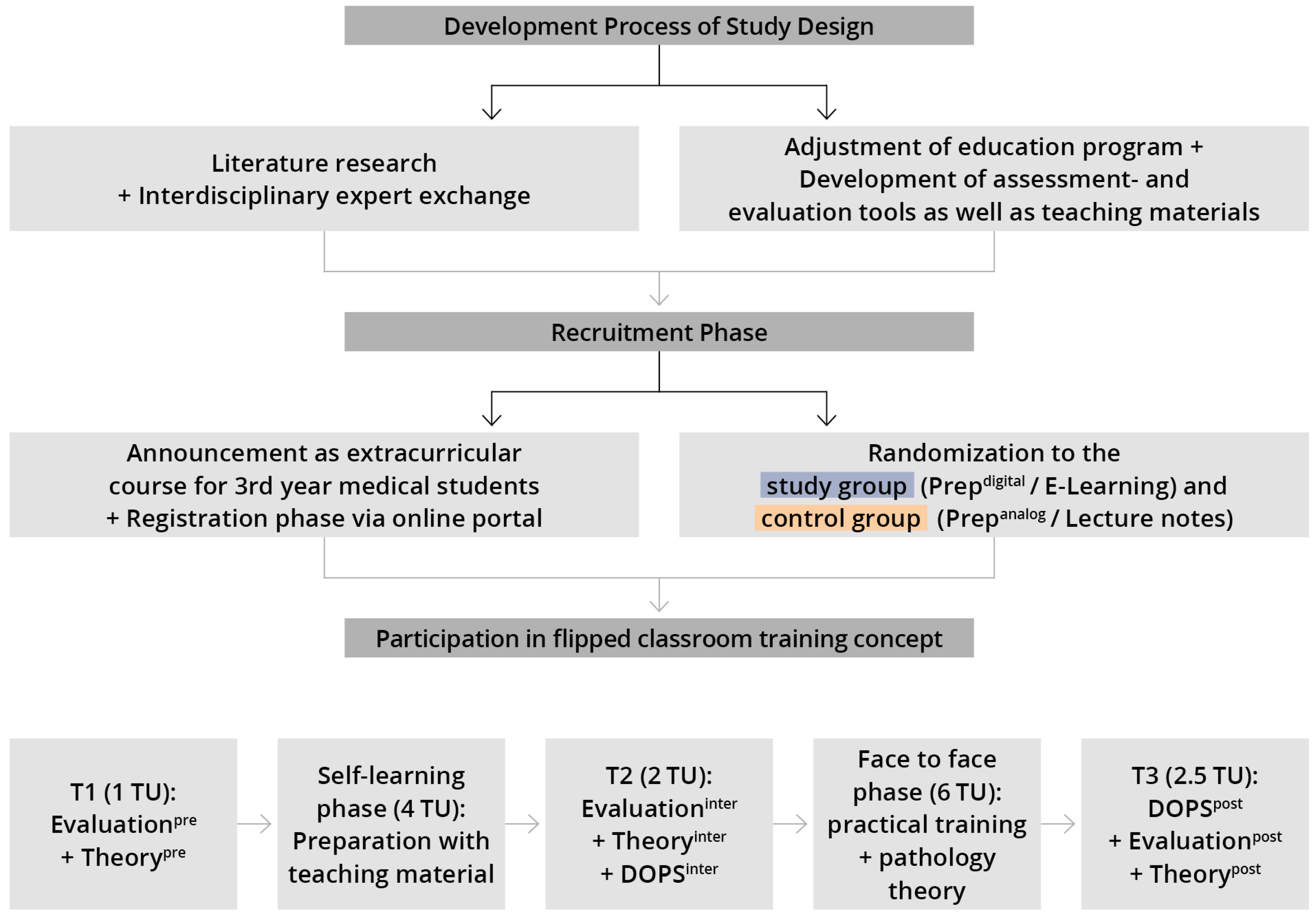
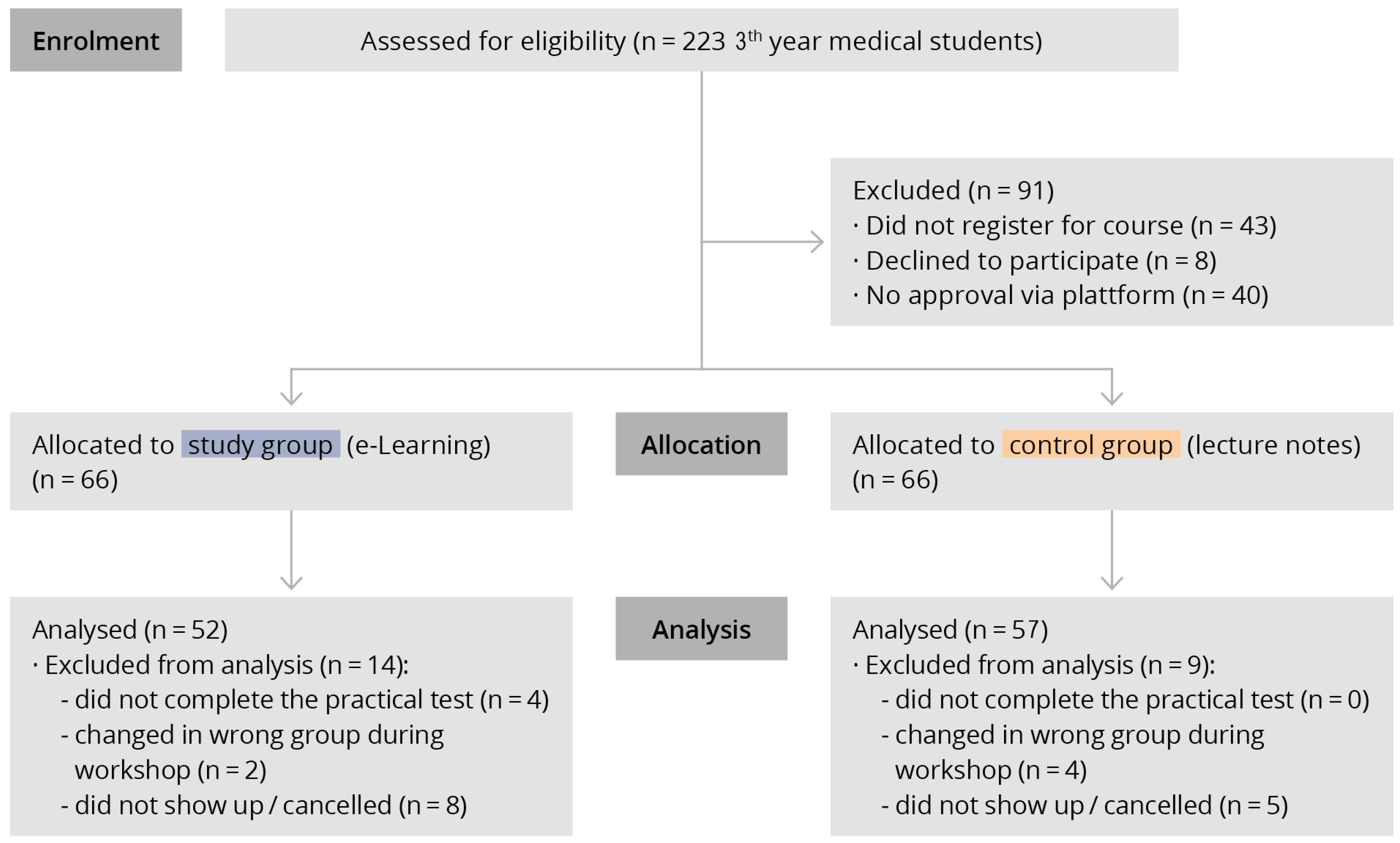
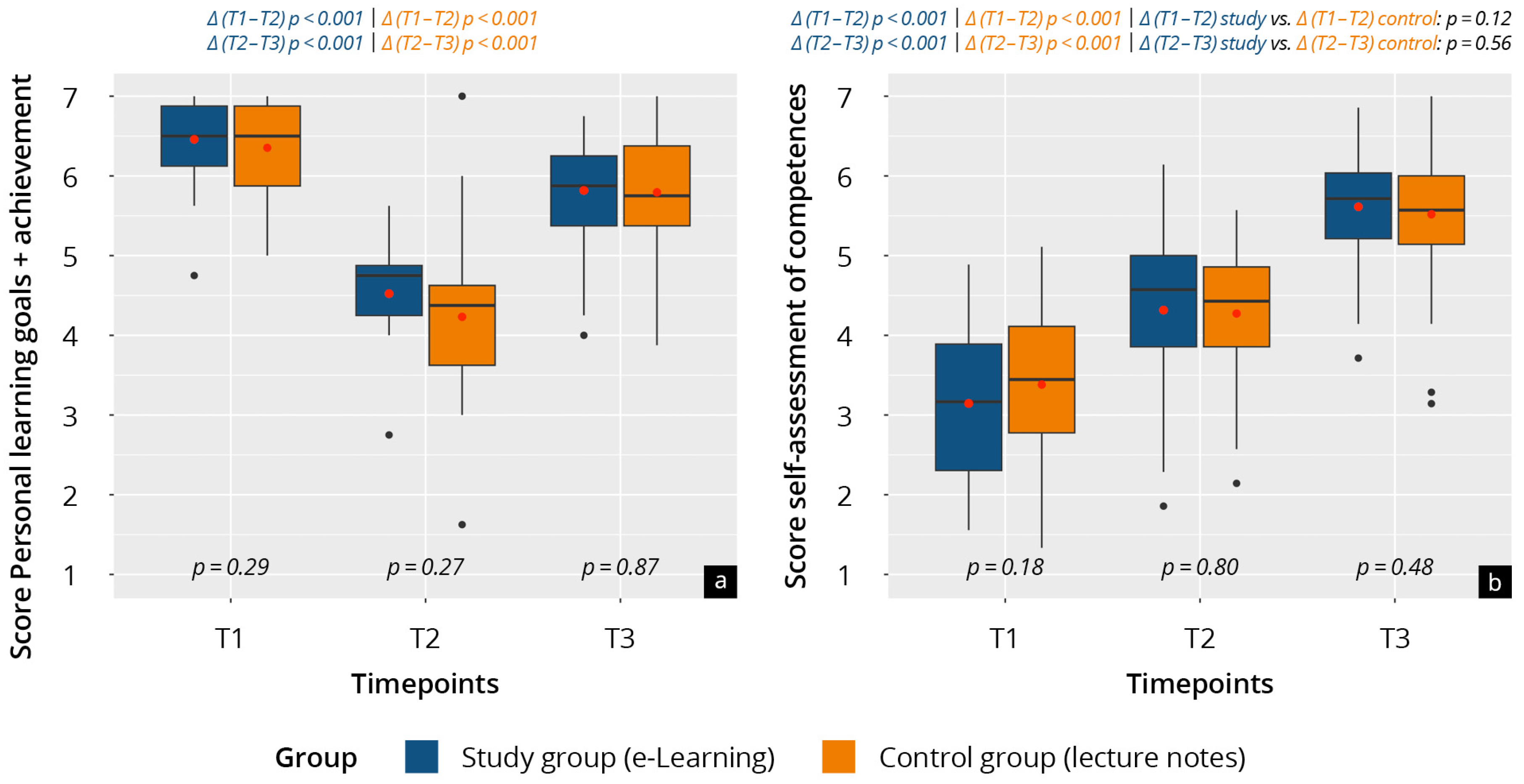
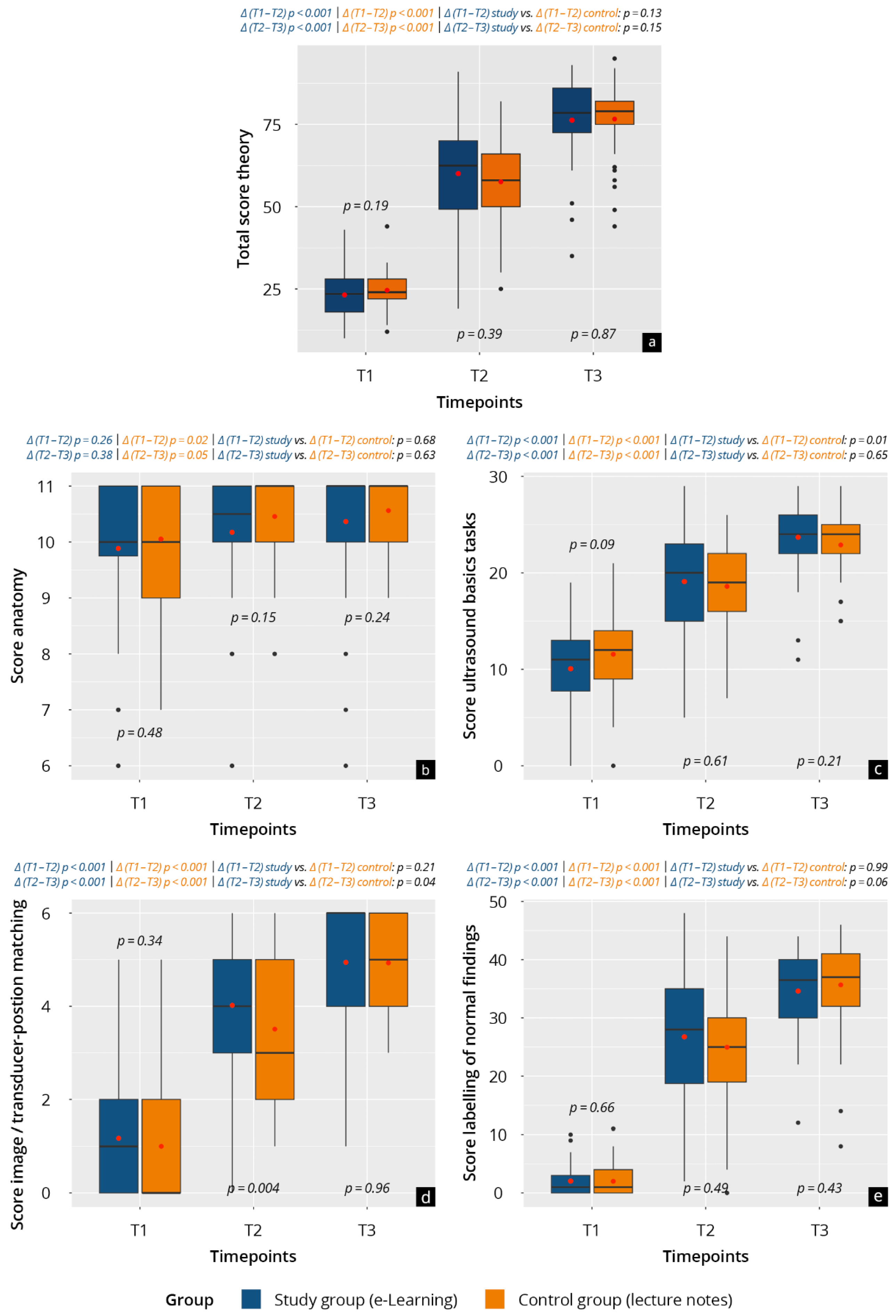
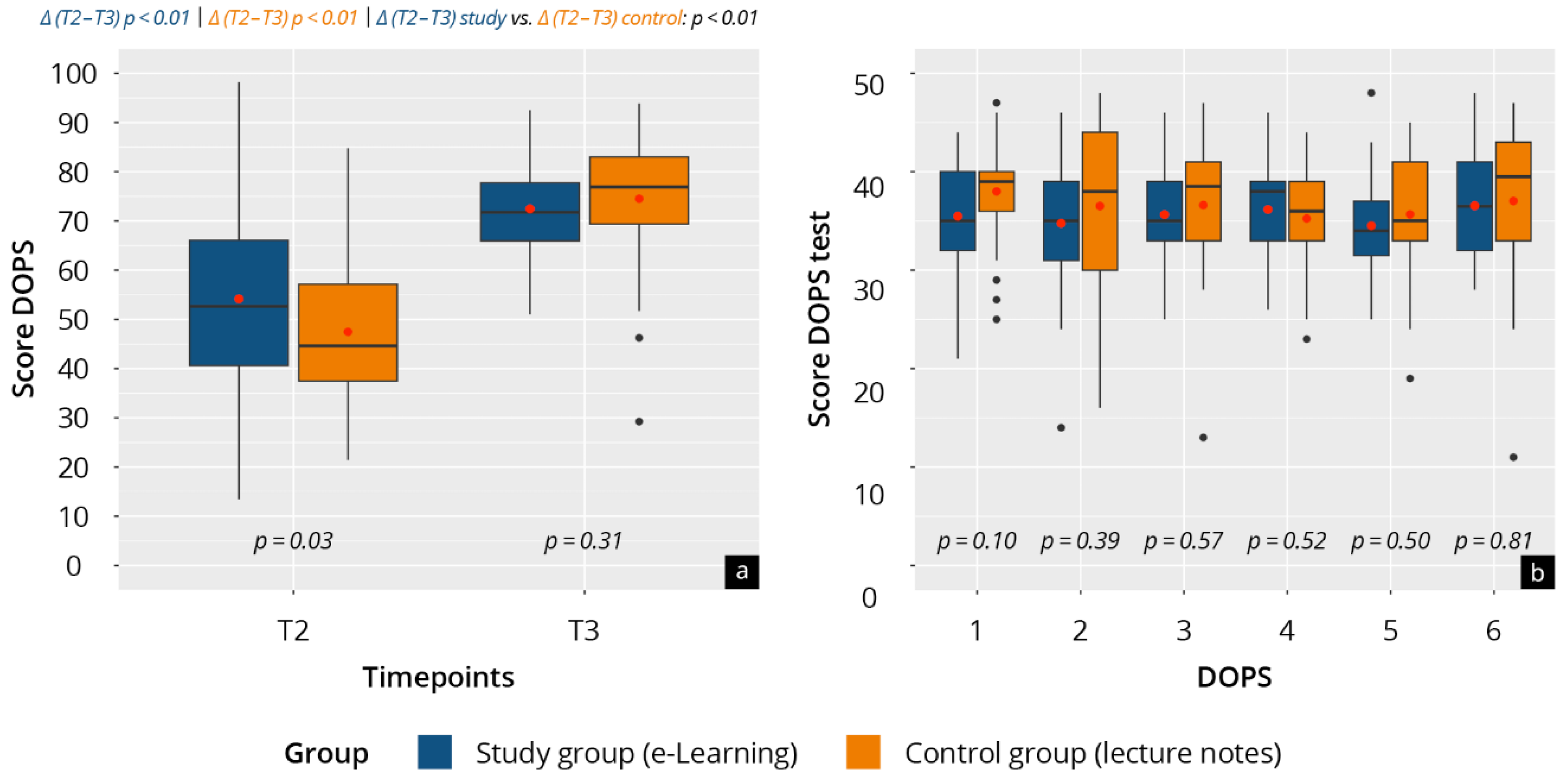
| Items | Study Group n = 52 | Control Group n = 57 | p-Value |
|---|---|---|---|
| T1 | |||
| Age | 25.6 ± 3.5 | 25.0 ± 3.6 | 0.21 |
| Gender | 0.61 | ||
| Female | 32 | 33 | |
| Male | 20 | 23 | |
| N/A | 0 | 1 | |
| Vocational training in the medical sector before studies | 0.43 | ||
| Yes | 34 | 32 | |
| No | 18 | 25 | |
| Experience with ultrasound | 0.38 | ||
| Yes | 30 | 27 | |
| No | 22 | 30 | |
| Experience with CT | 0.35 | ||
| Yes | 18 | 14 | |
| No | 34 | 43 | |
| Experience with MRT | 0.61 | ||
| Yes | 16 | 14 | |
| No | 36 | 43 | |
| Experience of interpretation of cross-sectional images | 0.6 | ||
| Yes | 18 | 16 | |
| No | 34 | 41 | |
| Previous participation in abdominal ultrasound course | 0.68 | ||
| No | 34 | 34 | |
| Yes | 18 | 23 | |
| Time frame: | 0.5 | ||
| 1 = <10 TU | 16 | 20 | |
| 2 = 10–20 TU | 2 | 3 | |
| 3 = >20 TU | 0 | 1 | |
| Observed/performed ultrasound | |||
| abdomen | 38 | 44 | 0.78 |
| head-neck | 12 | 19 | 0.33 |
| punctures | 21 | 17 | 0.34 |
| Observed an echocardiography | 0.46 | ||
| No | 9 | 10 | |
| Yes | 43 | 47 | |
| Time frame: | 0.3 | ||
| 1 = <10 examinations | 34 | 37 | |
| 2 = 10–20 examinations | 4 | 6 | |
| 3 = 20–50 examinations | 5 | 2 | |
| 4 = >50 examinations | 0 | 2 | |
| Performed an echocardiography | 0.27 | ||
| No | 27 | 24 | |
| Yes | 25 | 33 | |
| Quantity | 0.13 | ||
| 1: <10 | 25 | 31 | |
| 2: 20–50 | 0 | 2 | |
| T2 | |||
| To what extent did you use the teaching material provided to prepare for the ultrasound course? | 0.2 | ||
| 1–2 h | 6 | 11 | |
| 2.5–4 h | 29 | 35 | |
| 4.5–6 h | 15 | 10 | |
| 6.5–8 h | 2 | 0 | |
| 8.5–10 h | 0 | 1 | |
| Have you had any practical training in echocardiography since receiving the educational media? | 0.01 | ||
| Yes | 20 | 8 | |
| No | 32 | 49 | |
Disclaimer/Publisher’s Note: The statements, opinions and data contained in all publications are solely those of the individual author(s) and contributor(s) and not of MDPI and/or the editor(s). MDPI and/or the editor(s) disclaim responsibility for any injury to people or property resulting from any ideas, methods, instructions or products referred to in the content. |
© 2025 by the authors. Licensee MDPI, Basel, Switzerland. This article is an open access article distributed under the terms and conditions of the Creative Commons Attribution (CC BY) license (https://creativecommons.org/licenses/by/4.0/).
Share and Cite
Weimer, J.; Recker, F.; Krüger, R.; Müller, L.; Buggenhagen, H.; Kurz, S.; Weimer, A.; Lorenz, L.-A.; Kloeckner, R.; Ruppert, J.; et al. The Effectiveness of Digital vs. Analogue Teaching Resources in a Flipped Classroom for Undergraduate Focus Cardiac Ultrasound Training: A Prospective, Randomised, Controlled Single-Centre Study. Educ. Sci. 2025, 15, 810. https://doi.org/10.3390/educsci15070810
Weimer J, Recker F, Krüger R, Müller L, Buggenhagen H, Kurz S, Weimer A, Lorenz L-A, Kloeckner R, Ruppert J, et al. The Effectiveness of Digital vs. Analogue Teaching Resources in a Flipped Classroom for Undergraduate Focus Cardiac Ultrasound Training: A Prospective, Randomised, Controlled Single-Centre Study. Education Sciences. 2025; 15(7):810. https://doi.org/10.3390/educsci15070810
Chicago/Turabian StyleWeimer, Johannes, Florian Recker, Rebecca Krüger, Lukas Müller, Holger Buggenhagen, Sandra Kurz, Andreas Weimer, Liv-Annebritt Lorenz, Roman Kloeckner, Johannes Ruppert, and et al. 2025. "The Effectiveness of Digital vs. Analogue Teaching Resources in a Flipped Classroom for Undergraduate Focus Cardiac Ultrasound Training: A Prospective, Randomised, Controlled Single-Centre Study" Education Sciences 15, no. 7: 810. https://doi.org/10.3390/educsci15070810
APA StyleWeimer, J., Recker, F., Krüger, R., Müller, L., Buggenhagen, H., Kurz, S., Weimer, A., Lorenz, L.-A., Kloeckner, R., Ruppert, J., Waezsada, E., Göbel, S., & Weinmann-Menke, J. (2025). The Effectiveness of Digital vs. Analogue Teaching Resources in a Flipped Classroom for Undergraduate Focus Cardiac Ultrasound Training: A Prospective, Randomised, Controlled Single-Centre Study. Education Sciences, 15(7), 810. https://doi.org/10.3390/educsci15070810








